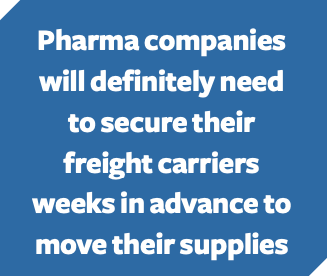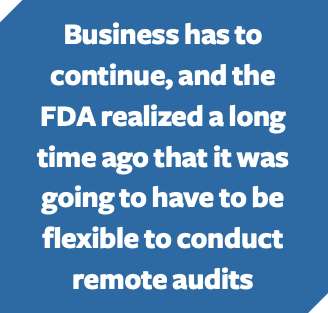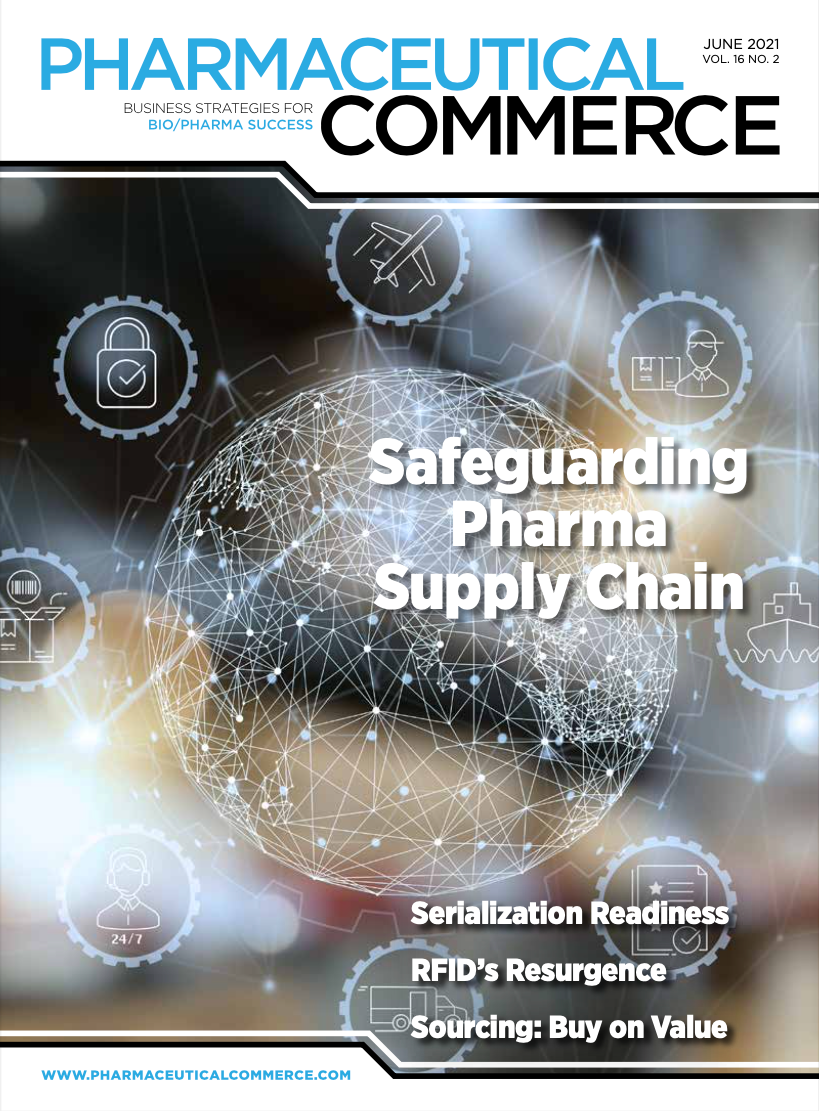People, production, and priorities
A conversation with Vin Colicchio, vice president, supply chain and external manufacturing, Dr. Reddy’s Laboratories
The global public health emergency over the past 15 months, like with many enterprises, has taught the life sciences industry some tough business lessons, while reinforcing principles and strengthening resolve when it comes to protecting its most critical asset—its people. One area in particular that reflects that necessary mix of human capital with tangible commercial output and customer goals is supply chain management. Pharmaceutical Commerce spoke recently with Vin Colicchio, vice president, supply chain and external manufacturing for Dr. Reddy’s Laboratories, about the challenging coordination and quick pivots in planning and decision-making that have been required to keep those qualities working in unison during the pandemic. A 30-plus-year industry veteran, being a part of the Indian multinational drugmaker, while based in Dr. Reddy’s Princeton, NJ, office gives Colicchio a unique perspective on Covid’s contrasting dynamics in the US and India, and what he stresses should be a “ healthy respect” for global logistics—those often unseen efforts to deliver medicines to patients as fast as possible.
1. Following the Covid-19 pandemic’s chaotic start, the global pharma supply chain, by many accounts, has mostly operated satisfactorily, with most shipments maintained. What industry practices or factors do you believe have been the key contributors in maintaining critical drug supply chain?
The key supply practices have always focused on the importance of sourcing adequate supplies of active pharmaceutical ingredients (APIs), and also the key starting materials that are used to manufacture the APIs; those are critical. In addition, you must ensure that your manufacturing operations have sufficient excipients and packaging supplies on hand to ensure that you can produce your products and can get them on the market on time.
Many companies previous to the pandemic may have only purchased two to three months of supply on raw materials and packaging components.
Now, most companies are taking a very assertive approach to getting more materials in-house, so they may purchase four to five months of supply of critical materials for these more valuable products.
There are different factors that have contributed, too. Early on in the pandemic, Dr. Reddy’s decided to focus primarily on ensuring the health, safety and well-being of our employees, and to put safe practices into place, especially for our manufacturing teams at the plants in India that are part of the Dr. Reddy’s network. When India went into a national lockdown, we had to ensure that we could get people safely from their homes to their places of work at the manufacturing plants. We were able to secure shuttle buses and meals for people, and able to make sure that we sanitized vehicles and the facilities so our employees operated in a safe environment. These actions were vital to allow our teams to manufacture our products under challenging circumstances.
Vin Colicchio, vice president, supply chain and external manufacturing, Dr. Reddy’s Laboratories

We had the plants running literally 24/7 during the pandemic and even now, amid the second phase hitting India, we’ve orchestrated it in a similar fashion. That’s very important to making sure that we can maintain our critical drug supply.
One of the other aspects we put in place was during the early days of the pandemic, we saw that logistics had to really spring into action very quickly. We had to secure air freight and sea freight transportation on a continued expedited basis, because the competition was doing the same thing. And while the sea freight was fairly available without a lot of constraints, the air freight was a different story. Many passenger flights were canceled. We had to secure cargo planes to move our products. So our India and US supply chain teams met daily to ensure that we had line of sight on when products had to get transported from India to the US. And doing that on an everyday basis—chartering flights, booking sea freight—and making sure that we had the travel logistics in place to move our products as quickly as possible was an integral part of maintaining our critical drug supply chain.
I also think the digital technologies were a plus. Before the pandemic, we used [Microsoft] Teams, but definitely to a much larger degree now, and Zoom came into this as well. Just having those technical platforms in place really helped transform the way that we dealt with rapid communication and managing our business. It was all about speed and connectivity.
2. As the US and much of the developed world are seeing generally declining Covid infection rates, can one argue today that perhaps a more secure supply chain has been a “positive” byproduct of the pandemic?
The pharma supply chain is more secure in terms of procuring more volumes of the needed materials to manufacture and distribute our products. We also work more effectively with our internal manufacturing plants and our contract manufacturing and packaging partners. To supply the North American market, Dr. Reddy’s uses our own manufacturing plants in India and the US, but we also have a network of contract manufacturing and packaging partners in India, Canada and in the US.
It’s a very compliant and secure supply chain. There are more checks and balances in place with more frequent business, material and supply chain reviews. The level of scrutiny and confirmation must be increased because if your partner doesn’t have adequate supply of APIs or production materials released, and you’re counting on them to deliver on time and in full, that could be quite disruptive. While Dr. Reddy’s has been very capable to secure its supply chain, we also demand that of our partners. We want to make sure that there are no weak links in the overall global supply chain and that we are able to count on the people, systems and procedures—both internally and with our business partners—to manufacture and supply our products to for our customers.
One of the other aspects of Covid is that there is a lot more direct discussion with the supply chain teams and our customers. Our customers want to know where their products are coming from, inventory levels and when are they going to be delivered. With anything that’s happening related to the pandemic or even recent weather-related events, now there’s a more open and very transparent, very timely set of discussions that could happen with our customers. That is a notable change since the pandemic started.

I would add that it’s the speed of processing as well. For us, it’s the advent of our work toward digitizing many of our processes. It varies very much by business, but in supply chain especially, we have certain processes that we’ve identified that have been or are in the midst of being automated. And not automation for the sake of automation, but automation to result in a true benefit—to get products manufactured and distributed faster to our customers.
3. How do you juxtapose the dynamics mentioned regarding improving pandemic trends in the developed world with the strain and demand on the supply for vaccines and PPE in India and Southeast Asia? How involved is your team at Dr. Reddy’s in some of those support efforts?
First and foremost, Dr. Reddy’s team in India performs at a very high level in terms of manufacturing operations and supply chain management. They’re dedicated to manufacturing, supplying and providing accessibility to our medicines. That’s the key focus.
At the same time, when you think about what’s happening in India with the surge and the unfortunate high incidence rates of the coronavirus and the death toll that it’s taking, our people continue to work very diligently while they’re taking care of themselves and their families. I look at that in comparison to the high demand of vaccines and PPE.
I think it’s very important to outline what Dr. Reddy’s has been doing to take care of its people while we’re also leveraging our business to manufacture products for our customers. We’ve taken a four-pronged approach across treatment, vaccines, hospital spaces and work shifts at the plants. For the treatment aspect, a year ago, Gilead provided licenses to eight manufacturers to produce and market remdesivir for Covid in over 100 countries. We were one of the eight companies to get that license. So we’ve been manufacturing remdesivir, and, at the same time, sequestering some of the inventory for our employees and their family members in India in need of it.
On the second prong of this approach, in particular we partnered with the Russian Defense Investment Fund (RDIF) to get access to its Sputnik V vaccine. Dr. Reddy’s conducted Phase II and Phase III clinical trials in India and we received emergency use authorization [in late April]. This means that we now have access to 250 million doses. And because it’s two shots for each person, it’s equivalent to 125 million patient doses. While this is less than 10% of India’s current population of 1.3 billion, it does provide us a great opportunity to treat people. At some point in time not only will we be treating the people that are in need, but it’s been announced that our employees and their families will be eligible for the vaccine as well. The first shipment has been made available in India and the dosing will commence as soon as it’s reasonably possible to do so. That’s a good development.
The third aspect is we have converted several of our building spaces into hospital rooms with hospital beds. We have designated areas in our plant environments called learning academies; they are conference spaces that have been converted with hospital beds and the necessary medical equipment so we can have employees and their families come over there and get treatment. As you know, it’s been difficult to get a spot in hospitals in India; they’ve been overwhelmed. So with that level of space availability, we’re able to take on people in there now. There’s about 75 rooms available at each of the three learning academy sites.
The fourth prong is that we normally run three shifts a day, six to seven days a week in our manufacturing plants. But what we’ve done is gone from three 8-hour shifts to two 12-hour shifts, and this enables us to minimize people exposure via shift changes. And we’re ensuring them access on the roads from their homes or their ability to travel. The feedback that we’ve gotten is that it’s clearly evident that the company’s focus is on the safety and health of its employees. That’s our No. 1 priority, to help our people and help their families.
It’s juxtaposing the simultaneous actions of manufacturing products and first taking care of our people, ensuring their safety and well-being.
4. There have been many capacity expansions across the globe in the pharma logistics business as a result of the pandemic—involving a range of organizations in this space, from technology and data vendors to air cargo companies, etc. Do you see that trend continuing, and how has the structure or dynamics of supplier/distribution relationships changed, if at all?
I definitely see it continuing. The supplier/distribution relationship is going to be very dynamic for years to come, and certainly depending on the industry—whether it’s technology or data, telecommunications, pharmaceuticals, whatever it may be. Much of this is driven by consumerism, of course, but with pharma, it’s driven by the need to get products out to our customers as quickly as possible in a secure and reliable manner.

There’s a shortage of freight-carrying capacity at this time. Container ships are at an all-time premium right now; more vessels are being built and there’s also a shortage of containers right now to support global trade. There’s going to have to be an increase in vessels and the containers. Pharma companies will definitely need to secure their freight carriers weeks in advance to move their supplies. It’s just a given, because there’s going to be a very strong continued relationship between the supplier and its distribution partners to ensure speed of service at a cost-effective rate.
The pace and volume of global trade is astounding and I see this activity intensifying over the coming years. Look at the recent example with the Suez Canal. The Ever Given container ship got jammed in place for seven days, and it really threatened the global trade market. There were ships considering taking the long way around the southern tip of Africa to get over to the Atlantic, while some just stayed in a holding pattern in the Red Sea and elsewhere. When a 20,000 container vessel gets landlocked in the Suez Canal and can bring the world to its knees in terms of disrupting the global supply, it gets on the radar of all industries. If you can’t get your Peloton bike on time or the latest iPhone, or, of course, pharmaceutical supplies, it’s totally disruptive.
When something like that happens, it does have the ability to affect things in a negative way. But at the same time, having a strong supplier/distribution relationship will reinforce all those positives. That’s something that we ensure is in place. You’ve got to have a healthy respect for global trade and logistics getting products to people as quickly as possible.
If you think about it in the context of launching a key product in a global supply chain. For instance, you source the active ingredient from India, you manufacture in one US location, and you package in another US location. You’re going to need to ensure that all those pieces come together at the right time. Having a solid relationship with your freight carrier company is pivotal to ensuring that you’re launching a product on time. The difference is millions of dollars in revenue. But more importantly, it’s making sure that your patients have access to this medicine that you’ve been planning on launching for several months.
5. Has there been increased focus and investment across the pharma supply chain in training around good distribution practice (GDP) standards?
Yes, we have seen that. Our teams in the US and India routinely undergo compliance training, and part of that is good distribution practices training for our warehousing teams and our supply chain people in logistics. We want to make sure that compliance is always maintained, and then we’re also on top of the most recent changes in any GDP specifications there might be. We want to ensure that our team in the US works very closely with our 3PL (third-party logistics provider) to improve and strengthen inbound and outbound capabilities. Because if they understand the GDP aspects more, then we have the ability to actually improve how our business operates.
6. Regulatory compliance is often an ever-shifting set of rules in pharma. Taking into account compliance with the Drug Supply Chain Security Act (DSCSA) in particular—and FDA’s deadline extension on enforcement of a number of new requirements, most notably saleable returns verification—what are some of the preparations and key challenges for you and your partners in serialization readiness?
When the deadline was put in place for Nov. 27 of 2020 and then it got pushed back by three years, we had already embarked on that project with our US team at Dr. Reddy’s, and we decided to stay the course. We knew that we did not want to disrupt the team’s progress because they were very close in getting everything mobilized for completion. We endorsed them continuing to move forward with that, and they were able to actually get that project completed for Dr. Reddy’s. Some other companies did that also while others decided that they were going to hold off [and focus on] meeting the new deadline.
Many of our contract manufacturing organization (CMO) partners also completed that or are currently finishing or in different phases of completion—and that’s important. We want to make sure that our partners are also following the DSCSA requirements and meeting those timelines for serialization. Our 3PL is working on its serialization capabilities and Dr. Reddy’s is lending support in that. We expect to see our 3PL finalizing and completing its project later this year; by then, we’ll have everything in the US locked down with serialization.
So it is coming into play; it’s taken some companies longer to implement than others. It is a complex endeavor, but it has been moving along steadily.
7. The pandemic has spotlighted the challenges of technology transfer a bit. Given your focus in external manufacturing, how has the world of tech transfers changed, if at all, in recent years? What new approaches are companies like yourself implementing in this area?
I would say that for us, the approach to tech transfers hasn’t really changed in terms of executing product transfers—whether you’re conducting a site transfer or you’re doing a scale-up, from a small-scale to a full-scale commercial manufacturing operation. From a regulatory point of view and from a scientific point of view, that hasn’t changed. But what has changed is the need for more lead time. One of the biggest challenges is there’s more complexity for certain technology platforms—if you have a complex-to-manufacture pharmaceutical product that is not your typical oral solid dosage product. Those require strong technical expertise and a lot of lead time, especially now with Covid.
Unfortunately, with absenteeism levels on the rise in certain parts of the world, in certain companies, you’re seeing that the manufacturing workforce could be impacted. You could see an impact in the quality control workforce, the quality assurance, or even the tech teams and R&D teams. When that happens, everything gets slowed down. So while in generics you want to move as quickly as possible to get products to market or to ensure that your tech transfers are getting approved as quickly as possible, you have to factor in a reasonable amount of additional lead time. In many cases, you simply need to plan for more lead time than you would have done in the past.
One of the other aspects is that, as always, you can leverage manufacturing capacities to ensure that tech transfers are done on time, while still providing for the supplies of your current commercialized assets, presuming they use the same lines and factories. While you’re focusing on your scale-ups and your tech transfers, you’re always going to have to simultaneously manufacture your commercialized portfolio. Sometimes that can kind of be in conflict, but companies have to balance that demand.
And then another factor is current FDA inspections are done virtually. The agency is assessing when it will start getting back physically into the plants to conduct its inspections, but for the time being, virtual inspections are being done. In that respect, it’s sometimes a bit of a challenge for pharma companies to work with that type of approach. But the best companies adapt to the new ways of working and become effective at managing through the inspections to yield favorable outcomes.

But it’s been happening for several months, and rather successfully to my understanding. Business has to continue, and the FDA realized a long time ago that it was going to have to be flexible to conduct remote audits.
8. What sparked you to pursue a career path in pharma manufacturing, supply chain and operations management?
I was always interested in science at a young age. I ended up focusing on engineering at Rutgers, and graduated with a B.S. degree in Biochemical Engineering. I always wanted to work in pharmaceuticals. Part of my draw to it was the ability to provide medicines to people. I always thought that was a worthwhile and noble endeavor. I initially worked in a fermentation and antibiotic refining unit for the former Lederle Laboratories, which became part of Wyeth and eventually Pfizer. I was a first-line supervisor and enjoyed the work a lot, getting involved with manufacturing of various pharmaceuticals. And then throughout the years, I was able to take on more responsible roles in manufacturing operations, engineering and supply chain. I had the opportunity to manage several manufacturing sites in various international locations and learn about different cultures.
It’s important to me that our teams do a great job of manufacturing and are able to supply on a timely basis to our customers. That’s something I’ve always enjoyed and have a passion for. If you can make a positive difference with your career to help people out and improve their quality of life, I can’t think of a better career than in the pharmaceutical industry.
